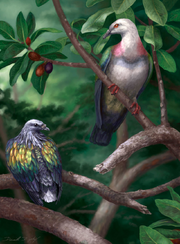Tongoenas burleyi is an extinct genus and species of giant pigeon that lived in the Tongan island of 'Eua.
Tongoenas burleyi inhabited the Tongan islands for at least 60,000 years, but vanished within a century or two of human arrival around 2,850 years ago. This canopy-dwelling species was about 51 cm (20 inches) long, not including the tail, weighed at least five times as much as the average city pigeon, and could fly. [1]
Description[]

Using the hindlimb and other osteological data as a framework, the plaeontologists have described a new extinct genus and species of pigeon, Tongoenas burleyi, from Holocene archaeological and Pleistocene paleontological sites on six islands (Foa, Lifuka, `Uiha, Ha`afeva, Tongatapu, and `Eua) in the Kingdom of Tonga.
Tongoenas was a large-sized member of the “arboreal” pigeon group, with osteological characters that relate it to Ducula, Gymnophaps, and Hemiphaga (generally canopy frugivores) rather than with the “terrestrial” pigeons (more ground-dwelling and granivorous) such as Gallicolumba, Trugon, Microgoura, Goura, etc. (others listed above). Among volant columbids, living or extinct, only the species of Goura (from New Guinea) are larger than Tongoenas. From most of the same prehistoric sites, the paleontologists also report new material of the nearly as large, extinct pigeon Ducula shutleri Worthy & Burley, recently described from islands in the Vava`u Group of Tonga. Thus, D. shutleri also was widespread in Tonga before human impact.
The prehistoric anthropogenic loss in Tonga of Tongoenas burleyi, Ducula shutleri, and other columbids undoubtedly had a negative impact on the dispersal regimes of Tongan forest trees. At first human contact about 2850 years ago, at least nine species of columbids in six genera inhabited the Tongan islands, where only four species in three genera exist today. [2]